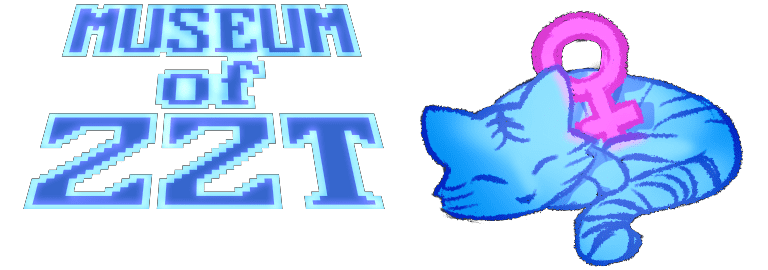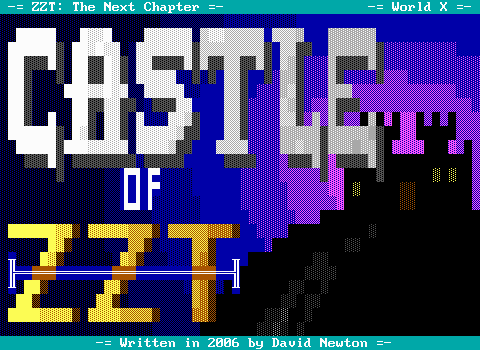My prayers were answered! At least, as much as they could have been.
It seems like yesterday that I decided to check out a short series that I had never heard of with Cliff Hensley's Gladiator. Its dull title screen mixed with some text attempting build up the game provided a poor first impression. Surely, it would be an "RPG" where the player would face off against a pile of tigers in a yellow bordered room while being told these were goblins and that you really should register this game for just $2.00.
Despite low expectations, I wound up discovering that it was in fact pushing narrative driven ZZT worlds boldly forward with its generous descriptions of boards that frankly weren't that far off from the yellow bordered rooms I was worried about. Hensley had me hooked with the story of Sir Edgar Knight, the aptly named wielder of the Gladiator sword, sworn to uphold the light and all that is good in the kingdom of Atheria.
It appeared to be Hensley's first game, and in many ways it showed. The starting board's yellow border is almost intact! You do fight a giant worm that's just a centipede that slowly meanders around outside a conquered tower soon to be locked in control of the evil (and aptly named) Darque Ness. There was a desert maze consisting of multiple screens of nothing but yellow fakes. It was certainly a beginner's game, but it had such strong potential for continued development thanks to its writing.
Hensley faltered significantly with his coding skills as well, understanding only the bare minimum of ZZT-OOP that would be necessary to make his game function. No flags tracked the player's progress, forcing them to use keys and doors everywhere to restrict access to later areas. NPCs that gave the player keys for plot progression or helpful supplies to aid Edgar were forced to vanish from the board afterwards to prevent the same items from being dispensed again and again. The final confrontation with Darque is won by touching them once, and they don't even move! Passage errors frequently dropped players in the wrong corner of boards making navigation awkward in a game that already had plenty of mandatory backtracking. It was in many ways quite a mess.
But the way it is written stood out so much compared to most ZZT games, making me always excited to enter any new screen and see how a basic rectangle with a smiley face in the corner could blossom into a dusty study with a wizened old elf poring over a library of old tomes. Hensley played to his strength and turned a cute little adventure of an over-represented style of game into one to remember.
It was obvious that the next game I'd play would be its sequel Gladiator: Knight's Saga, focused on Edgar's son Derek as he swears the oath of Gladiator after his father perishes in battle. The sequel shared many of the same challenges, with Hensley seemingly having learned nothing about ZZT-OOP in the time between the games' release. Despite this, he pushed even harder with his writing. Now focused less on elaborate description, and more tuned to character interaction. The game told the tale of Derek being framed for murder, fleeing the kingdom to its neighboring Borderlands where the people were under persecution from his former kingdom. All the while the real culprit remained at large, targeting those Derek found himself in close proximity to, taunting him with notes and a threat to kill the queen!
To make things even more impressive, Hensley introduced a dynamic storytelling system, giving players options of how to treat characters and which paths to take. The author went to extreme lengths to make these decisions possible without using flags to track choices, opting instead to create duplicate versions of boards at each story branch. Miserable as it must have been to create, the game had a number of splits which would impact all kinds of things ranging from where you go for your final mission, to who lives and dies, and even whether Derek ultimately moved on from the sword or redoubled on the promise he made to his dying father. The game was so clearly a labor of love, with Hensley punching above his weight to create what I'd now consider an all-time classic.
The second game started providing hints as to how the threat would escalate even more in the thrilling conclusion The Sundering. And yet, it was not meant to be. While the first two games had been available for years, the third game was nowhere to be found, and presumed to have never been made with no other worlds by Hensley preserved.
Until just a few weeks ago! After a dry spell with no rediscovered worlds, a number had once more dropped out of nowhere. And a demo for The Sundering as well as a collection of documents covering the kingdom of Atheria, its major players, locations, and its history were suddenly available. It may be not be much, and we'll likely never know what Hensley had planned for the game, but I can't ignore my wish to see more of the Gladiator series being granted, providing a chance to explore just a tiny bit of what was to be the most impressive chapter yet.
The world's destruction or salvation will soon be at hand. It's time for The Sundering.
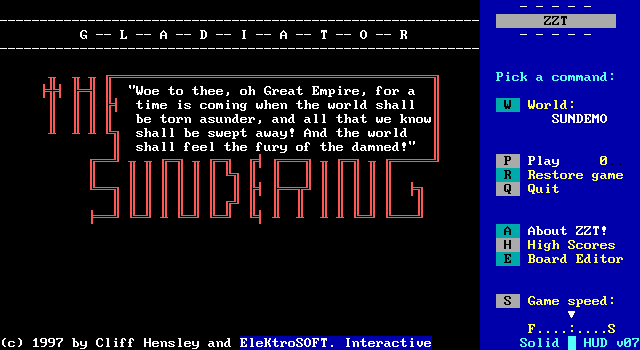
The demo for the game doesn't waste any time, starting players off in gameplay with no blurb about being a demo or recap of previous events. If you're here, it's expected that you've played the previous two games and are familiar with Atheria and its many battles with creatures of darkness.
The guard addresses the player as Shianna, resolving a mystery from the previous game as if it were nothing. Which of the possible endings would be used as the canon for the final game in the trilogy? Probably not the one where Shianna dies because Derek was too worried about returning to the kingdom he was still considered a murderer in. Nor is it the one I would have thought it was, where Derek's loyalty to the role of Gladiator, and oath sworn to his dying father led to him leaving the kingdom to continue his task. Hensley's idea of the character diverged from my own, making him a momma's boy who indeed passed on the role of Gladiator to Shianna so he could live at the castle with the queen he only just discovered was in fact his mother.
As we'll see, Derek hasn't abandoned his sense of justice, merely switched to a position that would allow him to be with his estranged mother and only living relative.

Which does make it kind of funny that as the new Gladiator, Shianna is now depicted as living within the castle when we saw her previous home in the Borderlands adjacent to Atheria. It seems like Derek didn't really need to give up his role, which could perhaps be something worth exploring, though nothing of the sort will be happening here. Now Derek is a captain in the royal guard which means he still regularly risks his life fighting evil.
Going with this ending though does mean we get ourselves a strong female protagonist deviating from the male dominated heroes you'd see just as often in ZZT as other games of the era. It also breaks the weird gender rule Hensley has used throughout the trilogy where women are depicted as , while the men are smiley faces. This rule is still in effect and still just as curious a thing to bother with as ever given how little anyone's gender has mattered, only now as the player's character can't be changed, Shianna gets to be uniquely smiling.
Back in Shianna's room, luxurious bed aside, the real thing to appreciate is our first sign that Hensley knows more about ZZT that he did while creating the first two games. STK graphics have finally arrived! In 1996 when the first game was released it wasn't too uncommon for a game to still be using nothing but default colors. For the second game it does make it feel a tad older than it really was. With each passing year, non-STK releases become more and more an indicator of an outsider making their games after having discovered ZZT and its editor without having any way to participate in its community where it was considered an indispensable tool that anyone who showed up should immediately have been pointed to so they could enjoy a world of grays, brown, and other dark colors.
Armed with STK, Hensley can make things look a bit more modern. The demo, which takes place entirely on castle ground unsurprisingly makes a lot of use of gray for stone walls and fortifications, with a touch of brown for wooden fixtures. It's still pretty entry level stuff, taking advantage of the extra colors with no real changes to the simple visuals of the previous games.
At the very least, the grass is a much more muted color compared to the flash bang of neon green that ZZTers are stuck with when sticking to the basic seven color palette. It is considerably easier on the eyes, which is worth far more than obsessions with realism in a text mode game even if considerations for STK colors were so often preoccupied with the latter.
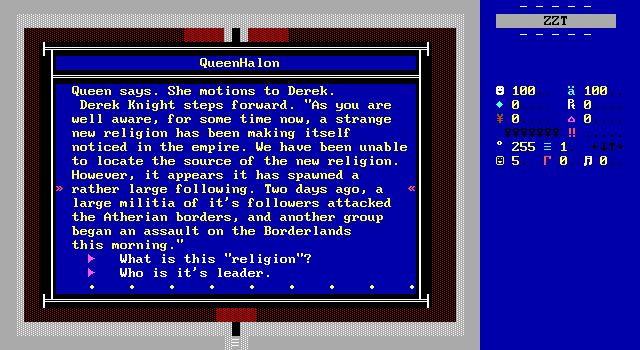
The main threat in this game stems from a new religion. It's a very generous way to describe what anyone else would opt to call a cult instead. Especially once the name is revealed. "The Order of Hate".
This new religion is sweeping the world! And its causing quite a stir with its teachings. What if... what if the light side was actually bad and the dark side was actually good? What if the Jedi were evil? Deep stuff for sure.
Despite the flimsy premise, it's been taking off in quite a big way. Perhaps the material conditions of Atheria are deteriorating and the people are looking for an out. Or maybe the big reveal that we won't get to see is a simple matter of hypnotism tricking people into pledging themselves to the order that is against order.
Regardless, this religion is also launching attacks on all two kingdoms that players are aware of. Currently the Borderlanders are yet again finding themselves at the mercy of an invading force that they are woefully incapable of dealing with. To that end, Donovitch has arrived as an emissary to ask if the Atherians could help out by sparing some of their troops to stop the threat before even more lives are lost.
It's a nice bit of political drama befitting the series. The last game had Atheria being the ones to invade the Borderlands to expand their own empire, only for the shared threat of the Dark Gladiator to help the two settle their differences. (Read: Get the Queen to stop the expansion her parents started and leave them alone.) Either their relationship must have cooled considerably for them to now be asking Atheria for help or else the situation is truly that grim.
Although Queen Halon has managed to stop the expansionist policies her parents began, ending the violence between the two kingdoms by agreeing to leave them alone, she struggles to make a commitment to help. The true nature of this threat is still unknown, and these same cultists are beginning to take a hold of Atheria as well. There's a real tension here as Halon has to decide if sending aid means putting her own kingdom at risk of similar attacks, while knowing full well that if she doesn't innocent people are going to be killed whose lives might otherwise be spared.
Part of what makes Gladiator such a unique ZZT game to me is how on a surface level it's a very simple story of good versus evil. Forces of darkness hatch a plan to take over the mortal world, and the Gladiator slays them with a not-quite holy vengeance. It seems very straightforward and basic, but the details muddy the morality so much more. Atheria has been a conqueror and a protector. The Atherian Liberation Movement in the second game was hoping to remove corrupt politicians from their government, and probably through violent means. This same government also had members working with the ALM in the first place. And when "corrupt council member" means the evil vizier who has summoned a dark creature from another realm, it's hard to find fault with the more extreme measures the Borderlanders' group is implied to be willing to take.
The characters of Gladiator all see themselves as doing what's best, with conflict arising from their ideas clashing with one another. This is such a rarity in ZZT, where even games that have been praised for their narratives tending to only introduce conflict in more straightforward good versus evil terms. Mr. C in Chrono Wars, Algar in Rhygar, Nyarlethole in Evil Sorcerers' Party. These villains and their flunkies get to steal the show, with rarely a dispute between what to prioritize, or whether this is the right way of going about things. Gladiator has the possibility of drama regardless of who is in the scene, and best of all there's no obvious correct answers here.
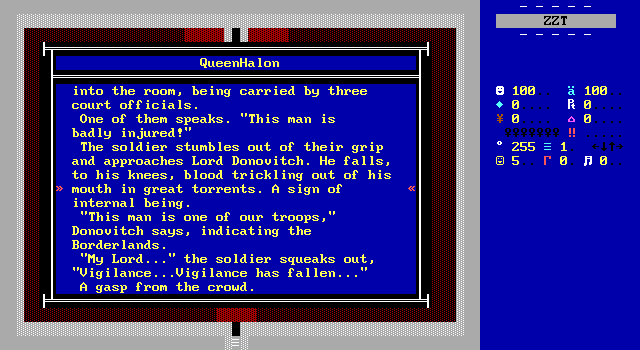
But the squabbles of resource allocation and debates about how on the hook the neighboring kingdom is when your people are dying from invaders are interrupted by a dying man from the Borderlands delivering news that really puts the threat into perspective. Vigilance, the capital city of the Borderlands has fallen to the Order of Hate.
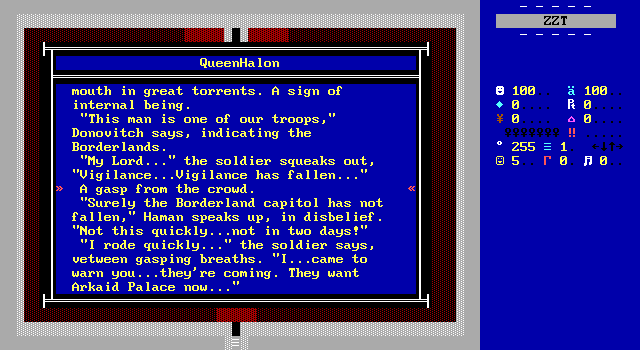
No one, not even Donovitch expected anything like this. The siege lasted a mere two days before the cultists brought down the most well defended city in the kingdom, and as their mission is not one of empire-building, but one of total annihilation, their forces are en route now for their next target: Arkaid palace.
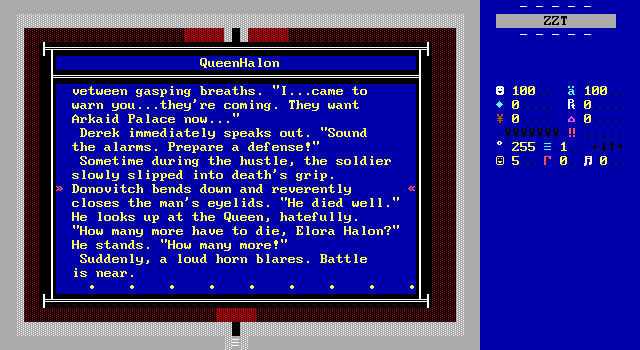
I'm fond of the cliché "how many more line" here from Donovitch. You're not gonna get much support now my dude, your kingdom has just fallen and the soldiers you're asking to be sent to your kingdom are two seconds away from having to give their own lives for their kingdom instead.
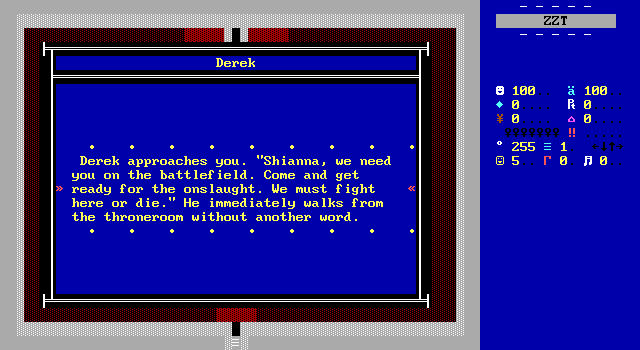
This leads to the demo's lone action sequence, where Hensley takes advantage of what he's learned about ZZTing recently to create numerous scripted battle sequences. Derek and Shianna prepare to do whatever is necessary to protect the castle and its queen (queen mom).
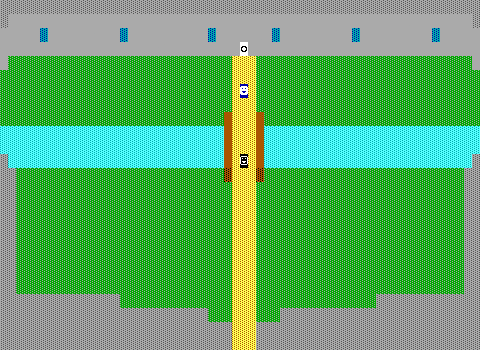
We get to see another freshly STK-ed take on a board from the previous game. The colors are easier on the eyes, but there's more to it than just that. The waters are brighter and less rigid, and the castle's walls now have some windows to give things a bit more detail. The writing always has and always will be the highlight of these games of course, though it's clear Hensley sees the benefit of giving players something to look at as well. While it might not be much, it is the best this series has looked.
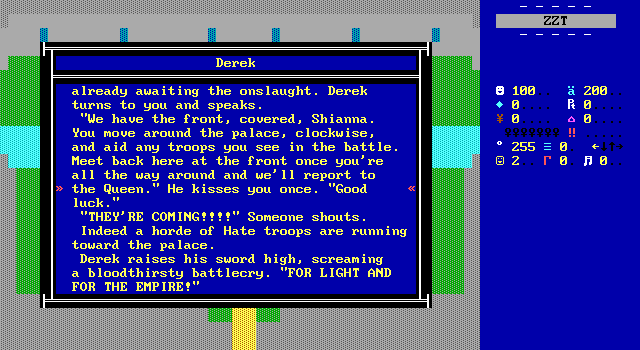
Currently things are peaceful, with the enemy's approach not having broken out into conflict just yet. Derek, no doubt thinking about how his father fought and perished in front of this very castle, takes the same position. The player, as Shianna, gets to circle the castle screen by screen clearing out any invaders and protecting the soldiers and civilians to the best of her ability. This is probably a good time to remind everyone that the Gladiator is only a tradition, and the title bestows its holder with no special abilities. Shianna and Derek are just two proud warriors with swords. Shianna's just happens to have some reputation attached to it.
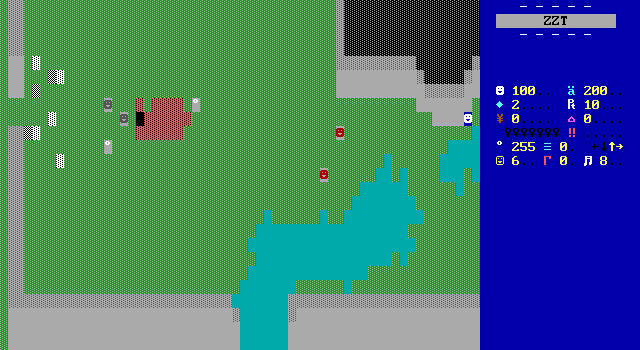
As much as Hensley's improved programming skills and expanded color palette help to tell the story, ZZT always gets the last word. Big battles between opposing armies are hardly its strong suit. Like any ZZTer though, Hensley does what he can to convey the mood he's aiming for.
To that end, a breach in the palace walls marks the entry point for three (one died already) Haters. (That's what I'm calling them now sorry.) Two guards rush at them, with the two exchanging volleys of arrows. This is Hensley's first foray into objects as more than still NPCs, so set your expectations appropriately. You get some hard-coded looping movement patterns interspersed with shooting.
What Hensley does that most wouldn't, is attempts to track the state of the fight a bit. Each enemy defeated whether by Shianna, the Atherian royal guards, or most likely, the much more trigger-happy Haters accidentally shooting each other, zaps a label the guards use to determine if they should keep fighting or stop moving. It's nice to see the good guys not continue to shoot at nothing once the enemies are defeated. The implementation breaks easily, as the guards use #BIND, leading to every surviving guard zapping a shared label. This leads to slacker guards stopping while enemies are still running around, and also means likely over-zapping a second label preventing guards from having saying that it's all clear when touched after the fight is over.
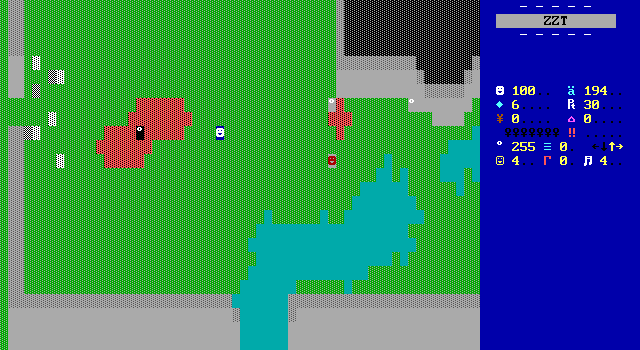
Sometimes it will still work out as the guards tend to die faster than the enemies unless players are going out of their way to protect them by tanking shots or countering with their own. Hensley has also figured out the time-honored technique of death = red slime, spilling blood all over the battlefield. The battle is certainly a violent one!
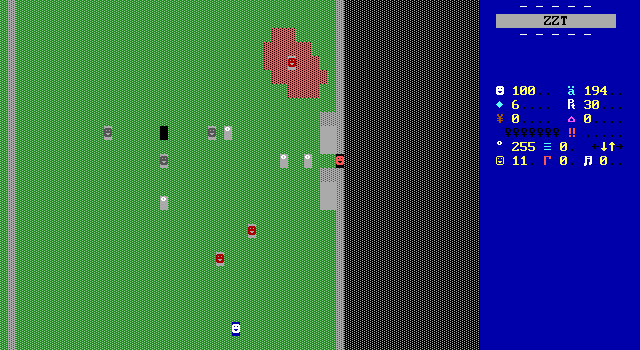
The earlier screens of combat each introduce something new so that it's not just the same clash of identical guards and Haters, though eventually the author will run of new surprises. Here we get to see pre-killed soldiers, ensuring that no matter how well you play the narrative is safe to talk about Atheria's losses. Even though the game detects when the Haters have been defeated, there's no overarching score with the ultimate outcome of the battle being fixed.
For extra support, a bowman sits atop the castle walls, shooting a perpetual volley of arrows. He has the misfortune of not being included when the game detects that the threat is gone, so he'll happily shoot at his comrades forever.
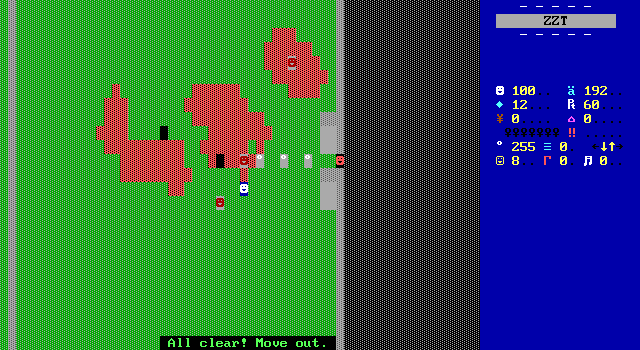
Say a prayer for this guard.
As the chaos envelops around you, you
come to the body of a wounded Atherian
Royal Guard. He lays in a pool of his
own blood, surrounded by an aura of death.
Cautiously, you kneel next to his body,
and he looks up into your eyes...
"Woman," he begins, slowly, "do you know
who I am?"
You shake your head no.
He closes his eyes for a moment, catches
his breath, and then continues to speak.
"How many of us have to die? What are we
dieing for...to all of you, we are but
nameless faces. You'll bury us and speak
of how great it is that we should give
our lives to save you all, but in reality
you'll forget us. We're all lost..."
"Tell me your name," you say, "so that
I may make sure that does not happen."
He looks at you, dumbfounded. "You just
don't understand..." And death takes him.
• • • • • • • • •
The one that appeared to already be dead features this great moment where Hensley dwells on the the faceless soldiers who give their lives in combat asks why. Like much of what Hensley writes about, it's not actually going to astound you with new ways of thinking about things, but it cares about a lot that your typical ZZT game would never bother to expound on. This soldier, knowing full well that he's going to die here, begins to wonder why he bothered. Whatever the outcome of the battle is, he'll never get to see it. He knows he gave his life here today only to be forgotten, just one of many valiant soldiers that will be honored as a collective but everything else about them forgotten.
Shianna promises that won't be the case, asking the man for his name so that his deeds today will be remembered forever. He then tells her that she doesn't understand a thing he's saying and dies. An incredible power move. You simply do not get this in any other games. And he's right! Shianna doesn't get it! A statue in this man's honor, or even a national holiday won't bring him back. He will be forgotten, or remembered only as a soldier who died in this battle. It's remarkably glum to witness this scene.
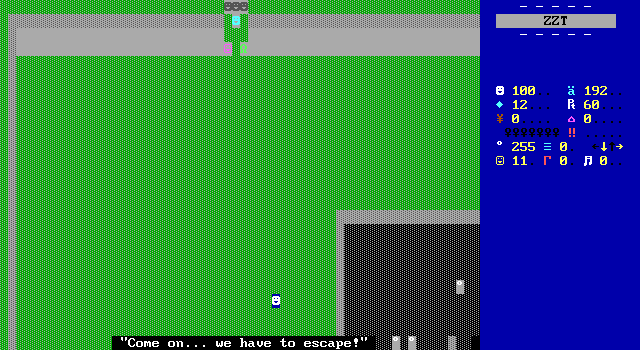
The horrors of war continue with Shianna only able to watch from afar as a few citizens make an attempt to flee the castle only to be slaughtered by the Haters. This time Hensley doesn't rub it in, letting the scene speak for itself.
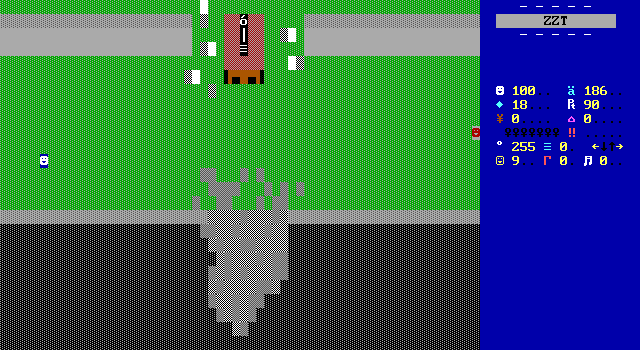
Again pulling himself ahead of the pack, Hensley isn't content for the raid on the castle to be comprised of nothing but smiley faces. A major breach in the northern wall of the castle is explained by a lovely looking catapult! As the scene unfolds, Shianna can again do nothing but watch the destruction as the machine chips away at the castle itself.
It doesn't really look the part in action as the bullets all come out from the bottom of the catapult in wide clusters, but it makes for an imposing crossing as getting caught by the bullets can mean a significant health loss.
I think this is the first time I've ever seen a catapult depicted in ZZT as well! A new vehicle after all this time, and just a wonderful design for it.
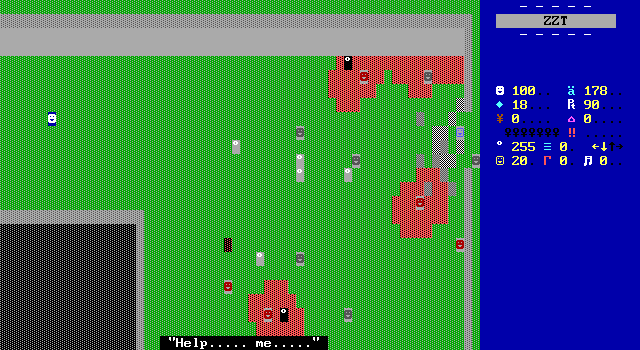
It kind of starts getting laid on a little thick. A bloody battle, a broken wall, a wounded civilian doomed to die. You know the score by now.
One guard is coded to answer the cry for help, only for the rightmost Hater to be waiting to ambush them before killing the civilian as well. It seems that while Shianna can easily fight off squads of five or more Haters, the Atherian royal guard (Derek notwithstanding) could use some training. The bodies here suggest severe losses and a grim future for Atheria.
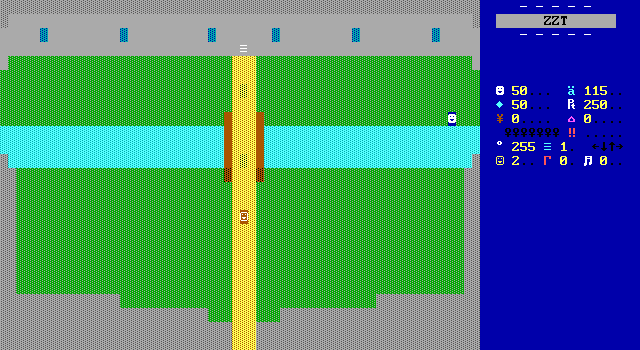
Nothing new is introduced as you finish making a circle around the castle.
Upon making it to the front again, Derek is still standing guard and quickly calls out to Shianna. While the screen remains undisturbed, Derek is described as being drenched in the blood of his opponents, and as worried for the queen. "A massacre", he calls it.
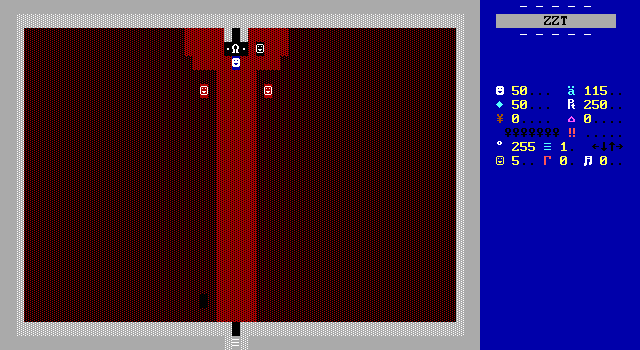
The debriefing carries a strong atmosphere of gloom with it. Though the Haters have been driven off, Atheria has suffered excessive casualties of both soldier and civilian. Queen Halon asks how long they'll be able to continue to sustain such attacks, with Derek struggling to bring himself to speak the answer: Another attack of such a scale would result in their demise.
It's a scene where Hensley gets to show off characters on good terms with one another struggling with their own conflicting ideas on how to proceed. Everyone knows they're on borrowed time. The next attack could come at any moment, bringing their destruction with it. Something needs to be done, but no one is sure what.
Haman, a religious man who was the one previously providing intel on the Order of Hate and their warped interpretation of the religious texts that he follows stirs in additional drama. He has gone full doomer, believing the current events to fit with a prophecy in the Books of Light. The Sundering is upon them. They can do nothing, should do nothing, and must accept that death will be arriving soon.
Hensley isn't just making this up as he goes either. This prophecy can be found in the previous game's collection of readable books. It tells of the end times. Fate decrees that at one point a dark prophet (which vizier Dagon called himself at the end of the last game) will arrive in the kingdom, spreading teachings opposite to those of Light until the Atherian empire is destroyed and the Gate of Darkness can be opened once more.
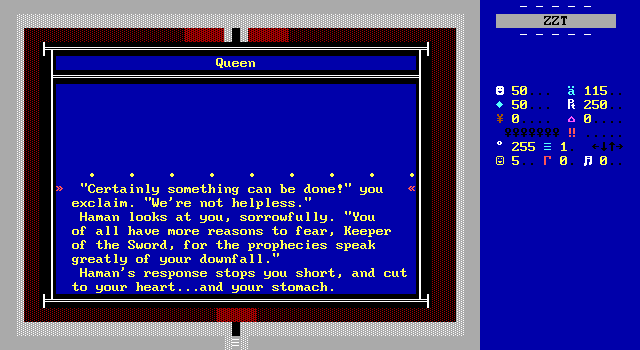
Haman is convinced that these events are the prophecy coming to pass, therefore any action any of them may take is destined to be futile. The only thing they can do is wait for the Warrior of Light's arrival. This Elysian being will judge the fate of the world, choosing either to save it from darkness, or destroy it entirely.
Needless to say, everybody in the room desperately wants this asshole to shut up while they come up with a better plan than lying down on the ground and waiting for death.
Donovitch in particular is annoyed with him, as the teachings of Light are but one religion, and not one commonly practiced by the Borderlanders whose nation began with exile from Atheria. Shianna is also not amused by his remarks that the prophecy goes out of its way to foretell of the Gladiator's inevitable failure. Derek, the former holder of the Gladiator sword, remains tight-lipped. Everyone in Atheria is in mortal peril, he's just in the weird spot of having just spared himself the embarrassment of a prophetic downfall only to have had his lover take his place.
It's a strong scene with a number of limited dialog branches, a mechanic seen in the previous game. Here it's mostly presenting players with a choice to make based on their own priorities, whether it be to learn the details of the prophecy or if they want to break up the argument to focus on planning what happens next. Gladiator purposely keeps players from knowing everything there is to know, providing limited information only on what you choose to learn more about. The general gist is still understood regardless of what information you acquire, with some encouragement to try the game again to see the other dialog paths, and if The Sundering was a finished game, the other gameplay paths as well.
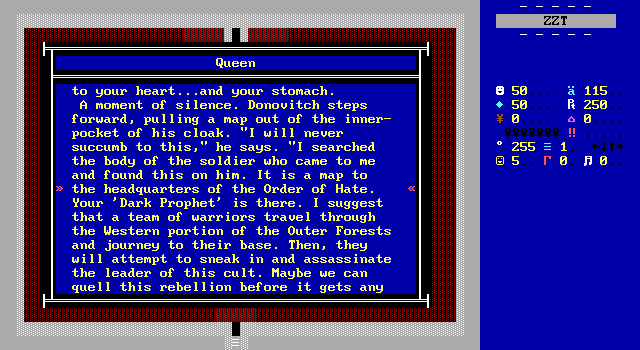
Finally, it's Donovitch who speaks up. While the others grimly contemplate the end of the Atherian empire being potentially moments away, it's the one who has already lost everything that is prepared to not see it happen to anyone else. Thanks to a map recovered by the dying soldier who informed them of the fall of Vigilance, they have a good chance of striking back quickly and discretely. A desperate mission of assassination is planned with the hope that by cutting off the head of the leader, the Haters following him will quickly collapse from the lack of organization.
Many governments have fallen for this logic to start a "quick" war, so I'm not too optimistic that it will be so simple. But at least it's a plan that can be enacted on such a short time frame. It beats listening to Haman at least.
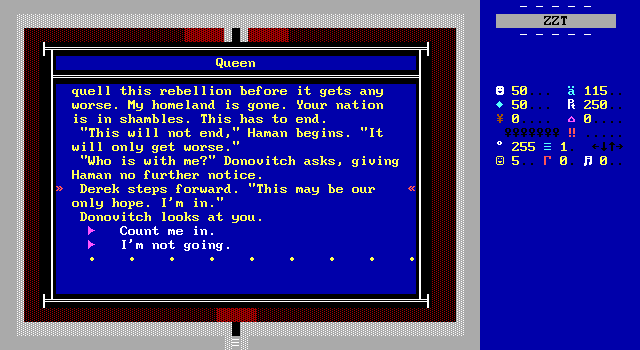
The way Haman continues his doom saying with the rest of the cast suddenly realizing they don't have to waste time responding to it is a lovely detail. His part of the story is done with, but Hensley doesn't immediately discard him. The sudden cold shoulder speaks volumes. Shianna, Derek, and now Donovitch are hardly the type of people to give up when they're needed most.
But then again, this is a Gladiator game. Despite it sounding like the game won't be able to continue, players are actually allowed to choose not to go. In the previous game, the big decision was if Derek was going to infiltrate the castle so that Gate of Darkness could be closed once more. Turning it down instead meant heading to the gate right away to deal with the demons currently breaking into the mortal world. It was a very unexpected alternate path. One that while impressive to include, felt like spitefully telling Hensley you weren't interested in his story. As if one were trying to trick the game master into having to throw out all their plans by being cold and abrasive to everything around them.
The same feeling applies here. Shianna can redouble her commitment to protecting the kingdom for as long as possible, splitting up the group as Derek and Donovitch proceed with the assassination plans alone. It seems like it would be another equally major split, and again one where saying you won't do what you've been asked to do seems like you're ruining Hensley's grand fantasy vision.
In Knight's Saga this level of a split in the storyline didn't occur until players were roughly 80% of the way through the game. This is happening in a twelve board demo. From the game's text file promising a "more affective" implementation of the interactive story system, I suspect there will be flags to make this easier. Still, I worry this was going to create a lot of extra work for Hensley who seems to have been falling into the post-Code Red trap of promising the biggest game with the most endings ever, a death sentence for basically any such game.
Derek steps to Donovitch's side. You, too
decide it is your duty to go.
"I'll go, Donovitch. As Keeper of the
Sword, I see it as my duty to accompany
you."
"I knew I could count on you two," he
says, putting a reassuring hand on both
your shoulders. "We leave immediately."
Derek and you bid farewell to the Queen.
Then, you turn to leave the throneroom,
and begin your journey...
• • • • • • • • •
Choosing instead to join the party kicks things into action, with the trio immediately setting forth, leading to a natural chapter break for the demo to end.
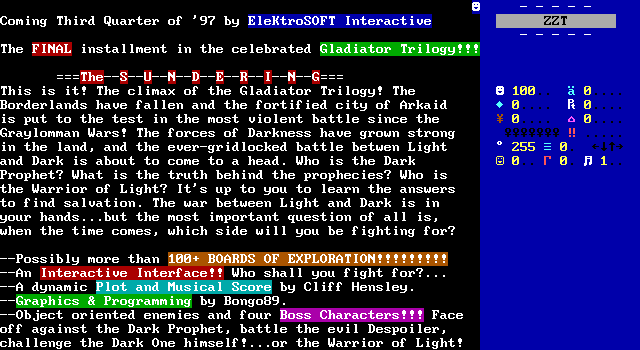
And end it does.
The Sundering ends with a lot of questions that will never be answered. This makes for a good demo. The stakes here feel higher than they ever have even after the first game went as far as to put the fate of the world in the balance. Players of the trilogy have only been to the Borderlands and Atheria, and in just a few short boards one has been defeated with the other hanging by a thread. Whatever Hensley had in mind to follow all this was going to be something brand new, and given his track record, I think there would be quite a number of surprises.
The blurb promises the usual, one-hundred boards, a dynamic story, the finest in graphics and sound, and offers a hint at just how many options players might have been intended to choose from. The fate of the world may yet again be at stake, only this time there's no simple macguffin of a gate to close (or keep shut) to do it. This was to be a story players could pull in a number of directions that had the misfortune of never being delivered.
Like most ZZT demos, the promises are a lot, and likely a big part of why the final game was never completed. Yet unlike the rest, Hensley has shown himself capable of delivering these things. Knight's Saga already pulled off the branching paths and dialog systems. The Sundering sounds like he knew how to do so much more effectively. Hensley's goals here feel achievable, and are certainly easy to adjust (nobody is counting 100 boards, most ZZT games don't have music...). Maybe the game got to be too much for him, or maybe he simply lost interest. All we're left with is to think of just what might have been.
Lore.txt
Well, and the lore guide.
Because if any ZZT game is going to have a lore guide, it's gonna be Gladiator. Also discovered along with a copy of the demo was a set of three documents covering the races, important figures, and history of Atheria.
I won't mince words. These documents are pretty dull. Hensley's world makes for a great setting to place these grand conflicts in. These worlds on their own aren't nearly as exciting. There are paragraphs about goblins and orc and trolls and dwarves, and I pretty much don't have to tell you anything about what that entails because it's "dwarves have beards" "orcs are big and strong" with some ties into the history to give them origin stories. It's Tolkien-adjacent.
The list of figures is incomplete, giving some background into where things like the Eternal Order that forged the Gladiator sword came from, along with some prophets and other figures before it gets to a heading for Edgar Knight and then stops with no more text. What little is here mostly concerns characters that are never mentioned in the games themselves. Perhaps these figured would have had more of a focus in the complete Sundering. As is, it's nothing more than trivia for a fandom that doesn't exist to commit it to memory.
Only the history document has anything really interesting. For one thing, it's written in character, by "Farman Deralik" an Atherian scholar. This one at least gets to expand on events discussed in less detail in the games. If you're wondering where Darque Ness came from and how he rose to power, this is the document for you. The birth of the mortal race, the time in which man and Elysian coexisted, and their eventual move to a new realm they created are all covered in a way that can be appreciated after playing the series.
It also attempts to take a stab at some of the background elements of the game that I assumed I was reading too much into, only for Hensley to dwell on them as well. The exile of the dwarves is politely glossed over, with the games presenting a view of events from the perspective of the kingdom that did the exiling.
To be clear, these are some amazing documents to have. Many a notebook was scribbled in at school with ideas and designs for ZZT games over the years. These documents, though unfinished, seem a lot more polished, very much intended for others to read, enjoy, and learn from. If you play this series for yourself at all, you absolutely should take a look if only to admire Hensley's unwavering dedication to creating such a rich and detailed world.
Final Thoughts
As far as The Sundering goes, the reality is there's not a whole lot to see here. It's nice to see Hensley discovering STK and how to use more of what ZZT-OOP can do. The scaffolding is there for this one to have been another impressive chapter in the saga. The game wastes no time getting into the central conflict. You get enough to jump in, meet the new characters, learn the stakes, and then plan a counterattack that teases the player with something to look forward to in the full game.
However, with nothing more for players to see and do other than have a chat in the throne room and then run a lap around the castle before returning for another conversation, it's hard to judge fairly. Hensley has been wowing me from the start, and I see little reason to think he'd falter now. But boy have ZZT games failed to deliver on their promises before, and one hundred boards is not something that comes easy to anyone. Between branching gameplay paths and multiple endings based on player choice, Hensley is creating a lot of work for himself plus those documents outside of the game making the game even larger in scope. It happened with Rhygar and it happened with its half-sibling Gladiator as well. The grand RPG that eventually stops being fun to work on, leaving players stuck imagining what the game might have been.
But as for the series itself, Gladiator to me feels like one of the most ambitious attempts at storytelling in ZZT for its first decade. It's easily a new favorite. The world feels like one with a real history to it that players slowly get to explore in the first two games. The way the characters don't always get along. The simple action gameplay that keeps things engaging while you move from one goal to the other makes for a grand adventure in a world that could easily be the setting for a dozen more. Seeing how Hensley begins barely able to stitch a game together, gluing it together with his writing to transform the basic into something truly memorable. Unlike Rhygar, this series seems to have been overshadowed and forgotten, with a nary a reference to it to be found, which is an absolute shame. If you've any love for those ZZT RPGs that rely on lions as adversaries rather than to power RNG in combat engines, this is one you've got to experience.
